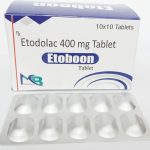Is Tramadol An Anti Inflammatory Drug?

Tramadol is a medication that is used to treat moderate to severe pain. It is a synthetic opioid analgesic often prescribed to patients suffering from chronic pain conditions such as arthritis, fibromyalgia, and lower back pain. While tramadol is not classified as an anti-inflammatory drug, it can help to reduce inflammation in some cases.
In this article, we will explore the various aspects of tramadol, including its mechanism of action, uses, side effects, and potential risks. We will also delve into the question of whether tramadol is an anti-inflammatory drug or not. So, let’s get started!
What is Tramadol?
Tramadol is a centrally-acting synthetic opioid analgesic that is used to treat moderate to severe pain. It works by binding to mu-opioid receptors in the brain and spinal cord, which results in the inhibition of pain signals. Tramadol is available in both immediate-release and extended-release formulations and is usually taken orally.
How Does Tramadol Work?
Tramadol works by binding to mu-opioid receptors in the brain and spinal cord. These receptors are responsible for the transmission of pain signals in the body. When tramadol binds to these receptors, it inhibits the transmission of pain signals, which results in pain relief.
In addition to its effects on mu-opioid receptors, tramadol also inhibits the reuptake of serotonin and norepinephrine in the brain. Serotonin and norepinephrine are neurotransmitters that are involved in the regulation of mood, anxiety, and pain. By inhibiting their reuptake, tramadol increases the levels of these neurotransmitters in the brain, which can help to improve mood and reduce anxiety.
Is Tramadol an Anti-Inflammatory Drug?
Tramadol is not classified as an anti-inflammatory drug. Anti-inflammatory drugs, also known as nonsteroidal anti-inflammatory drugs (NSAIDs), are a group of medications that are used to reduce inflammation in the body. Examples of NSAIDs include aspirin, ibuprofen, and naproxen.
While tramadol is not an anti-inflammatory drug, it can help to reduce inflammation in some cases. Tramadol has been shown to inhibit the production of pro-inflammatory cytokines, which are proteins that play a role in the inflammatory response. In one study, tramadol was found to reduce the production of cytokines such as interleukin-6 (IL-6) and tumor necrosis factor-alpha (TNF-alpha) in patients with osteoarthritis.
However, it is important to note that the anti-inflammatory effects of tramadol are not as potent as those of NSAIDs. If you are experiencing inflammation, it is best to talk to your healthcare provider about the appropriate treatment options.
Uses of Tramadol
Tramadol is primarily used to treat moderate to severe pain. It is often prescribed to patients who have chronic pain conditions such as osteoarthritis, fibromyalgia, and lower back pain. Tramadol is also used to treat pain after surgery or injury.
In addition to its pain-relieving effects, tramadol has been shown to have antidepressant properties. It has been used off-label to treat depression and anxiety in some cases.
Side Effects of Tramadol
Like all medications, tramadol can cause side effects. The most common side effects of tramadol include:
• Nausea and vomiting
• Headache
• Drowsiness
• Dry mouth
• Sweating
In some cases, tramadol can cause more serious side effects, such as:
• Seizures
• Serotonin syndrome (a potentially life-threatening condition that can occur when there is an excess of serotonin in the body)
• Respiratory depression (slowed breathing)
• Hypotension (low blood pressure)
• Allergic reactions
It is important to talk to your healthcare provider if you experience any side effects while taking tramadol.
Risks of Tramadol
Tramadol carries some risks, particularly when it is misused or abused. Because tramadol is an opioid, it has a potential for addiction and dependence. Long-term use of tramadol can lead to physical dependence, which means that the body has become accustomed to the drug and experiences withdrawal symptoms when the drug is stopped.
Tramadol can also be dangerous when it is taken in high doses or when it is combined with other medications or substances. Combining tramadol with alcohol, for example, can increase the risk of respiratory depression and other serious side effects.
Some people may misuse or abuse tramadol in order to experience its psychoactive effects. Taking tramadol in higher doses than prescribed or crushing and snorting the medication can increase the risk of experiencing a “tramadol high.”
A tramadol high can produce feelings of euphoria, relaxation, and well-being. Some people may also experience a sense of detachment from reality, as well as visual or auditory hallucinations. However, it is important to note that a tramadol high can also cause a number of unpleasant and dangerous side effects.
Taking high doses of tramadol can cause respiratory depression, which can be life-threatening. Other potential side effects of a tramadol high include seizures, serotonin syndrome, hypotension, and allergic reactions. Tramadol can also be addictive, and long-term use can lead to physical dependence and withdrawal symptoms.
Conclusion
Tramadol is a synthetic opioid analgesic that is used to treat moderate to severe pain. While it is not classified as an anti-inflammatory drug, it can help to reduce inflammation in some cases. Tramadol works by binding to mu-opioid receptors in the brain and spinal cord, which inhibits the transmission of pain signals.
Tramadol can cause side effects, including nausea, constipation, dizziness, and drowsiness. It also carries some risks, particularly when it is misused or abused. If you are prescribed tramadol, it is important to take it as directed and to talk to your healthcare provider about any concerns you may have.
In conclusion, tramadol is not an anti-inflammatory drug but it can help to reduce inflammation in some cases. It is primarily used to treat moderate to severe pain and carries some risks, particularly when it is misused or abused. If you have any questions or concerns about tramadol, it is important to talk to your healthcare provider.





